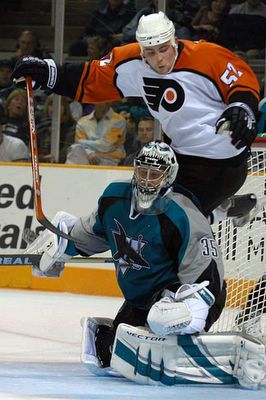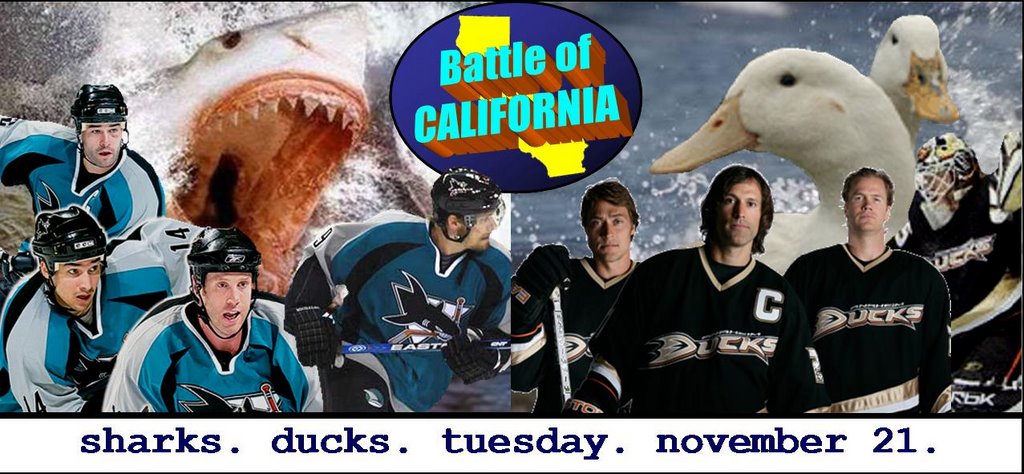 Nothing gets you drinking like giving up 7 goals to the Flyers (on 16 shots? Wow.). Random thoughts (warning: a long, directionless, Red Label-inspired post):
Nothing gets you drinking like giving up 7 goals to the Flyers (on 16 shots? Wow.). Random thoughts (warning: a long, directionless, Red Label-inspired post):
Anyone wanna trade for George Parros? That guy’s a human zamboni, using his jersey to slide-sweep the ice. Jeez, Burke. I’m not so sure. Todd Fedoruk was a great fighter and could even contribute in his minutes (the easy ice time, with Getzlaf and Perry). Shawn Thornton maybe wasn’t that great a fighter, but he did really well in the Fedoruk minutes. Parros? I dunno. He’s got the balance of a drunk infant giraffe. A real downgrade.
------------------------------Yeah, by the numbers it looks pretty stunning that bottomfeeders Ottawa and Philadelphia would shock world-beaters Buffalo and Anaheim, but really, these teams were due. Mudcrutch
makes the point pretty well, and JavaGeek does a good job with the
Senators specifically. Sucks to say, but the Sens and Flyers aren’t as bad as they were letting on, just as the Sabres and Ducks aren’t as good as they were letting on.
------------------------------Stats rant: John Kreisler, an NHL.com columnist (the “numbers” guy) had a
note on the Flyers (emphasis mine)The Flyers have a league-low 30 goals (including one in a shootout), though it’s not for a lack of trying. They’ve out-shot their opponents in 12 of their 15 games -- including the last eight, in which they are 2-6-0.
When I look at the
NHL standings, why does a shootout win/loss count as a statistical goal? Isn’t that already reflected in the
W or
O column? I mean, I don’t care particularly about the counting method, but when you look at player stats,
nobody gets credit for scoring a goal or a game-winning goal. A winning goalie does not get a save, nor a losing goalie a goal-against. It is, in fact, a phantom goal. If you want to put a shootout win in the goals column, then award a damn goal, dumbass league.
------------------------------While I’m on the topic of numbers, here’s another thought. I’m really into the mathy stuff being done around the blogosphere, ranging from
ice time analysis to shot chart analysis (both
on the ice and
on the net). More and more, people like us are getting a better and better handle on gathering the data elements of hockey and learning how to read them
(through no help of the NHL, mind you). There’s no perfect metric to this sport, of course, but I think the first strides made in data analysis won’t have to be perfect to be effective. It’s just that raw a game.
At any rate, I would humbly like to add one thing to JavaGeek’s excellent
data wish list. For every goal scored, I think there should be some sort of data collected about
why the goal was scored. Was there a screen? Was it a breakaway? Did the puck deflect? Was the goalie caught in a 2-on-1? Was it just a perfect shot? This it seems to me is just as important as where on the ice the puck was shot or where on the net it was aimed.
We know fundamentally that understanding winning means understanding scoring, both from a productive sense and a preventive sense. I am really in favor of data collection about shot modeling, but I think there should be better differentiation about
which goals to model around. My two cents, any way.
------------------------------Um, I have slammed Hockey News
in the past, but there’s two pieces in the issue I just picked up of some interest (I don't have a link). One is about shootouts, and really breaks down where on the net shooters aimed (hint: glove-side high). The other is about declines in attendance, and writer Ken Campbell, I think, kicks some real ass.
Saskin, on the other hand, tells me he isn't the least bit concerned, even though the players' pay checks are directly tied into how many fans they attract. Saskin reasons enough teams raised ticket prices to make up for the revenue shortfall and he has every confidence when final receipts are tallied, the league will exceed the $2.1 billion in revenue it made last year... wasn't the lockout and cost certainty supposed to be in large part about maintaining affordable ticket prices?... Remind me again exactly why it was we missed a full season of hockey if a significant number of teams can paper the house and still report enough in revenues to give the players well over a billion dollars in salary.
------------------------------As a conclusion to this directionless drinky post, I would like to throw one more idea out there. If the NHL is really serious about the 'watchability' of hockey (which I don't think is measured in goals, by the way), one area I think it might want to take a look at is at the blue line. So hard to penetrate, so easy to defend! Somehow if the offsides rule was more 'relaxed', I think, there would be better flow to games and more chances. Here's three ideas, going conservative-to-radical:
1) Fatten the blue line. Allow a forward to break in earlier when the puck touches blue.
2) Personal tag-up on-sides. Right now if one player is offsides, everyone has to tag up. In this version, only that one player needs to tag up while others can continue "offsides".
3) Allow one forward to be offside. This is really radical, but a whistle would only be blown if two players were offside.
The real idea, I think, is to make things harder to defend. To make scoring chances easier to come by (or at least, more frequent). To get tripped up a little bit less by the stickiness of the neutral zone. At the very least, changing the blueline would have to change the way the game was defended, which at this point is almost a game of "clear the zone".
------------------------------OK, I'm not even sure if this all makes sense, but Drinky Sleek is putting a stop to this (the typing, not the drinking). Good luck, everyone! Rational posts start tomorrow!






































